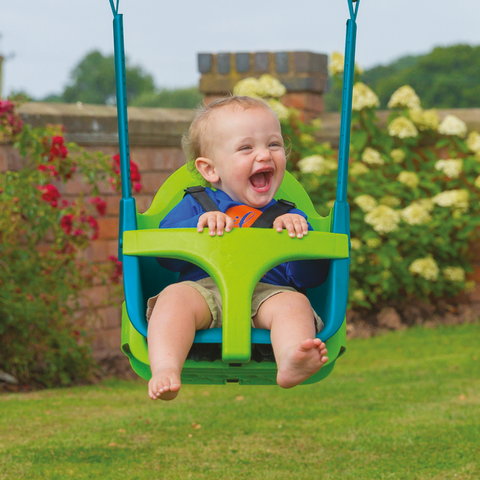When it comes to choosing a baby swing, whether it's for outdoor fun, a quaint baby garden swing in a garden nook, or a dedicated swing set, safety is paramount. With numerous options on the market, discerning parents want to ensure that their selection offers not just enjoyment but also peace of mind.
This article delves into the crucial safety features that every parent should look for in a baby swing, emphasising the importance of certified safety standards, robust design, and regular maintenance. Highlighting our innovative toddler climb & swing, the versatile foldaway baby swing, and the adaptable Quadpod swing seat, we'll guide you through making a choice that’s safe, secure and offers years of joy from 6 months to 6 years of age.

What Are the Essential Safety Certifications or Standards for Baby Swings?
Safety certifications form the cornerstone of trust between parents and manufacturers, ensuring that baby swings, including those found in baby swing sets, are subjected to stringent assessments. The Consumer Product Safety Commission (CPSC) and standards recommended by the American Academy of Paediatrics (AAP) are critical benchmarks. These certifications guarantee that baby seats & swings undergo thorough testing for stability, strength, and the use of safe materials, substantially mitigating the risk of infant deaths and accidents.
Additionally, compliance with international safety standards such as EN71 in Europe, which covers mechanical, physical properties, and flammability tests, further assures the global safety of these products. It's also important to look for certification marks that indicate a product's compliance with specific safety standards, providing an added layer of assurance that the infant swings, particularly those part of a baby swing outdoor set, not only meet but often exceed essential safety requirements.
These efforts ensure that every swing we place our child in, whether it's a standalone or part of a set, is a sanctuary of safety and joy.
How Important Are Secure Harnesses and Proper Seat Design of a Baby Swing?
A secure, heavy duty harness and proper seat design are paramount in ensuring the safety of our youngest adventurers. They play a crucial role in preventing babies from falling out or sustaining injuries during use. A five-point harness system, mirroring the safety specifications found in car seats, is highly recommended to prevent babies from slipping or tumbling out.

Additionally, the seat's design must offer comprehensive support for a baby's back, neck, and head, which is crucial for infants who haven't yet mastered the ability to sit up independently. This support is vital not only for safety but also for comfort, reducing the risk of discomfort or injury from falling asleep in an upright position.
Moreover, adjustable features that grow with your child, breathable materials for comfort, and easy-to-clean surfaces add layers of convenience and safety, ensuring the swing remains a secure and cherished part of family life.
What Should Parents Check Regularly on a Baby Swing?
Regular checks are imperative to maintain the swing's safety integrity. Parents should meticulously inspect for wear and tear, loose screws, and the sturdiness of the swing set. The weight limit and the swing's ability to remain in a safe, reclined position are critical factors to monitor, ensuring the swing adapts as the baby grows. Ensuring the fabric is clean and free from potential allergens or irritants is also essential.
Additionally, verifying that the swing adheres to updated safety guidelines and standards can prevent unforeseen hazards. Checking for recalls or safety alerts related to the product is also a prudent practice, as it helps maintain the utmost safety for your child.
Crucial Factors to Consider:
- Adherence to Safety Protocols: Prioritise swings that not only meet but surpass the rigorous standards established by authoritative entities such as the CPSC and the AAP's guidelines. These protocols are the cornerstone for averting potential infant hazards associated with product usage.
- Design Excellence and Secure Harnessing: Opt for a baby swing that boasts an ergonomically sound seat, offering substantial support for the baby’s back, neck, and head, coupled with a reliable harness system to maintain them securely in place. Proper design and harnessing significantly mitigate the risk of injury from potential falls or slumping over when the babies sleep.
- Build Quality and Consistent Upkeep: Seek out swings constructed from durable materials designed to endure various weather conditions, especially for outdoor setups. Performing routine maintenance checks is vital to ensure the swing’s components remain intact and functional.
- Versatility and Durability: The Quadpod swing seat, designed for longevity, adapts to your growing child, providing safe and comfortable seating options from infancy through to six years old. This feature represents a lasting commitment to your child’s safety and recreational enjoyment.
- Guidelines for Safe Sleep: Although baby swings can offer solace and amusement, they are not intended for long sleep periods. It's imperative to transfer the baby to a safe sleeping arrangement, in line with the AAP’s safe sleep recommendations, should the baby in the swing fall asleep.
Conclusion:
Selecting a baby swing with the right safety features is not just crucial—it's fundamental for your baby or child's well-being and your peace of mind. By prioritising products that adhere to certified safety standards, are equipped with secure harnesses, and boast proper seat design, you can guarantee your baby swings safe into a delightful experience.
Our meticulously curated range of baby swings, which includes the adventurous toddler climb & swing, the space-saving foldaway baby swing, and the adaptable Quadpod swing seat, fully encapsulates these vital safety principles.
Together, they offer a harmonious blend of safety, enjoyment, and durability, making them perfect choices for families seeking reliable and fun outdoor or garden swing options.





